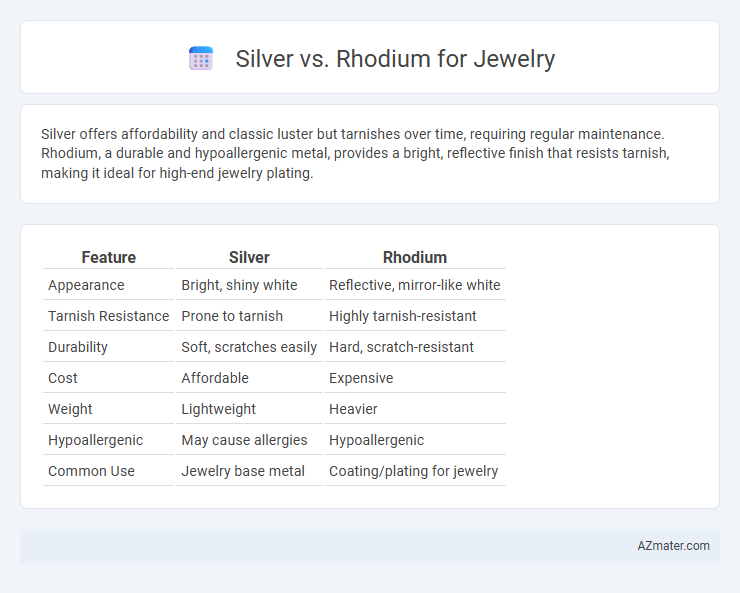Silver offers affordability and classic luster but tarnishes over time, requiring regular maintenance. Rhodium, a durable and hypoallergenic metal, provides a bright, reflective finish that resists tarnish, making it ideal for high-end jewelry plating.
Table of Comparison
| Feature | Silver | Rhodium |
|---|---|---|
| Appearance | Bright, shiny white | Reflective, mirror-like white |
| Tarnish Resistance | Prone to tarnish | Highly tarnish-resistant |
| Durability | Soft, scratches easily | Hard, scratch-resistant |
| Cost | Affordable | Expensive |
| Weight | Lightweight | Heavier |
| Hypoallergenic | May cause allergies | Hypoallergenic |
| Common Use | Jewelry base metal | Coating/plating for jewelry |
Overview: Silver vs Rhodium in Jewelry
Silver is a popular metal in jewelry due to its affordability, bright luster, and ease of crafting, but it tarnishes over time with exposure to air and moisture. Rhodium, a rare and durable precious metal in the platinum group, is primarily used as a plating to enhance jewelry's shine, increase scratch resistance, and prevent tarnishing. While silver offers a classic look and affordability, rhodium's hardness and reflective properties make it ideal for white gold and silver pieces requiring long-lasting brilliance and protection.
Composition and Properties
Silver, primarily composed of 92.5% pure silver alloyed with copper (sterling silver), offers a bright white luster and excellent malleability but is prone to tarnishing over time due to oxidation. Rhodium, a rare platinum-group metal with a naturally white appearance, is highly durable, corrosion-resistant, and provides a reflective finish that enhances jewelry's shine and longevity. The distinct compositions influence their properties: silver's softness makes it suitable for intricate designs, while rhodium plating is often applied to silver jewelry to improve hardness and prevent tarnish.
Appearance and Shine
Silver offers a bright, white luster that can develop a natural patina over time, adding character to jewelry pieces. Rhodium, a rare and durable metal, provides an exceptionally reflective, mirror-like shine that resists tarnishing and maintains its brilliance longer. Jewelry coated with rhodium enhances the appearance by delivering a sleek, polished finish that outshines traditional silver's subtle glow.
Durability and Wear Resistance
Silver, primarily composed of sterling silver (92.5% silver), offers moderate durability but is prone to tarnishing and scratches over time, requiring regular maintenance to preserve its shine. Rhodium, a rare and hard platinum-group metal, provides superior wear resistance and corrosion protection, often used as a plating material to enhance the durability of jewelry while maintaining a reflective white finish. The significant hardness of rhodium compared to silver makes it highly resistant to scratches and deformation, extending the lifespan and appearance of jewelry pieces coated with rhodium.
Tarnish and Maintenance
Silver jewelry tends to tarnish quickly due to its reaction with sulfur compounds in the air, requiring frequent polishing to maintain its shine. Rhodium, known for its high resistance to tarnish and corrosion, offers a low-maintenance option with a durable, reflective surface. Regular cleaning with mild soap and water is sufficient for rhodium-plated pieces, making them ideal for long-lasting brilliance without extensive upkeep.
Hypoallergenic Qualities
Silver and rhodium are popular metals in jewelry, but rhodium is highly valued for its superior hypoallergenic qualities, making it ideal for sensitive skin. While silver may cause allergic reactions due to its copper or nickel alloys, rhodium plating provides a protective barrier that prevents direct metal contact. This makes rhodium-plated jewelry a safer choice for individuals prone to metal allergies or skin irritation.
Cost Comparison
Silver jewelry typically costs less than rhodium due to the abundance and lower market price of silver, making it a budget-friendly choice for affordable accessories. Rhodium, a rare and precious metal with superior durability and tarnish resistance, commands significantly higher prices, often more than ten times that of silver per ounce. Consumers opting for rhodium-plated jewelry pay a premium for enhanced shine and longevity, while solid rhodium pieces represent an investment in luxury with corresponding cost implications.
Popular Uses in Jewelry
Silver is widely favored for its affordability and classic shine, making it popular in rings, bracelets, and earrings, especially in vintage and bohemian styles. Rhodium's superior durability and brilliant white finish make it a preferred choice for plating platinum or white gold jewelry, enhancing resistance to tarnish and scratches. Both metals are essential in fine jewelry, with silver used extensively in costume pieces and rhodium applied mainly as a protective coating to maintain luster in high-end designs.
Care and Cleaning Recommendations
Silver jewelry requires regular polishing with a soft cloth to prevent tarnish caused by exposure to air and moisture, and using a specialized silver cleaner helps maintain its shine. Rhodium-plated jewelry benefits from gentle cleaning with mild soap and water, avoiding abrasive materials that can wear down the plating over time. Storing both silver and rhodium pieces in anti-tarnish pouches or airtight containers minimizes oxidation and prolongs their appearance.
Choosing the Right Metal for Your Style
Silver offers a classic, affordable option with a bright white sheen that complements casual and vintage-inspired jewelry styles. Rhodium, known for its superior durability and brilliant reflective finish, is ideal for modern, high-end pieces requiring long-lasting shine and scratch resistance. Selecting between silver and rhodium depends on your lifestyle, desired maintenance level, and preference for either timeless elegance or contemporary brilliance.

Infographic: Silver vs Rhodium for Jewelry
 azmater.com
azmater.com